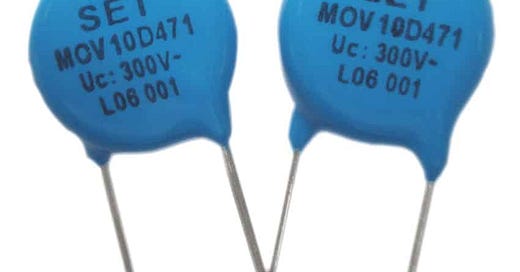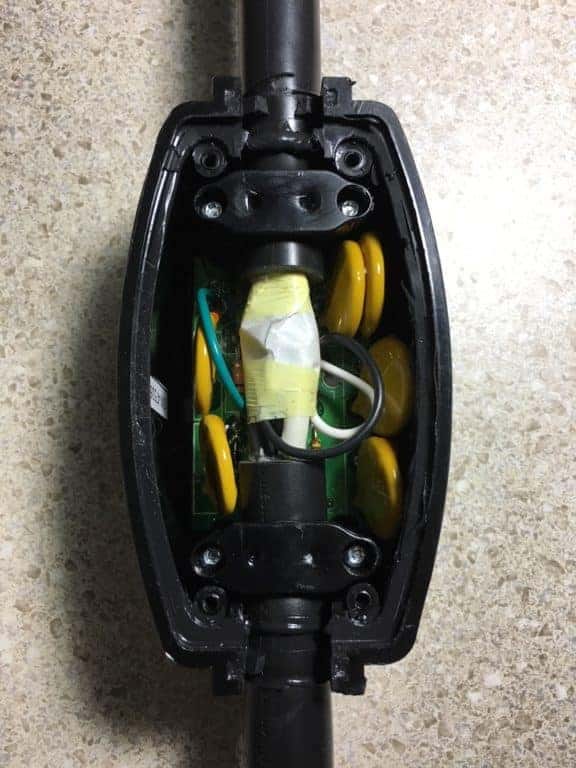Surges and Joules and MOVs, Oh My!
What exactly is a MOV device, and what is this Joule rating we always see on surge protectors?
Dear Mike,
After reading all your articles about voltage problems, I’m now in the market for a surge protector but a little confused by all these Joule numbers. Some are rated at 1,400 Joules of protection, while others are 2,100 or even 4,200 Joules. So first of all, how do you pronounce Joules, and just what are they? If these gadgets are so important, how come RV manufacturers don’t build surge protectors into their RVs at the factory? —Russ
Dear Russ,
You sure ask a lot of questions, which shows me you’ve been doing your homework. So I’ll answer them in order.
Answer #1: What is a Joule?
First of all, Joule is pronounced just like Jewel, those sparkly things that cost so much. And since you asked, each Joule is equal to 1 watt-second of energy. So 1 watt of energy for 10 seconds equals 10 watt-seconds, which equals 10 Joules. Just as 10 watts of energy for 1 second equals 10 watt-seconds or 10 Joules. And 1,000 watts for 1 second equals 1,000 Joules, etc. It’s a linear relationship so basic addition and multiplication is all the math you need.
Answer #2: What is a MOV?
Next, inside of every surge protector is something called a MOV, which is an acronym for Metal Oxide Varistor.
The job of the MOV (pronounced like Mod, from the Mod Squad) is to clamp any dangerous peak voltage surges (spikes) that might come in through your shore power line. It would take at least a few articles to explain all the possible causes of these voltage surges and how to stop them, so for now we’ll just concentrate on the energy absorption aspect of the MOV devices inside a surge protector.
Each MOV has two important ratings. Peak voltage is how high the surge voltage is allowed to get before the MOV goes into action and shorts (clamps) it out. Don’t worry about that one for now. But MOVs are also rated for Joules of energy absorption. You can imagine that a small voltage surge might only cause a small amount of energy to be absorbed when it’s clamped by a MOV, while a large voltage surge would cause a large amount of energy absorption, and you would be right. A standard size MOV device like you find in a typical surge protector is rated for 350 Joules.
But wait, there’s “more”!
So how do the manufacturers get higher Joule ratings? Well, you can put a number of 350 Joule MOV devices in parallel to increase the total amount of energy dissipation. Here’s what the inside of a surge protector with 2100 Joules of surge protection looks like. Note there are six (6) MOV devices inside, each one rated for 350 Joules. A little arithmetic shows us that 6 x 350 = 2,100. Yes, six MOVs times 350 Joules per MOV equals 2,100 Joules total of surge protection in this case.
As far as protection from voltage surges go, more Joules are better. That’s because all MOV devices are sacrificial. That is, a MOV rated for 350 Joules can take a single 350 Joule hit from a surge, or it can take ten 35 Joule hits. And after it’s had all the voltage surges it’s rated for, the MOV is now worn out and can’t protect your electrical system from voltage spikes any more.
That’s why all quality surge protectors have some sort of indicator light to show that their MOV devices are healthy and the surge protection is still working. But once that light goes out you know it’s time to have the MOV devices replaced by the manufacturer. I’ve looked inside of a bunch of different surge protector products, but only Hughes sells a DIY replacement MOV module for their surge protectors. So always contact the manufacturer about how to get this done.
Answer #3: Why aren’t Surge Protectors built into RV's?
Finally, the 64 million dollar question. Why don’t RV manufacturers include some sort of surge protection device in their RVs from the factory? Well, it’s really about the money. I’m sure that Surge Guard, Progressive Industries and everyone else would love to put one of their surge protectors in every new RV. But it’s a hard sell because that would increase the cost of every new RV in an already highly competitive market. So for now, at least, it’s an optional device in all but large coaches and 5th wheel RVs.
Future possibilities…
However, there is talk from the NEC about requiring some sort of surge/polarity device in all new RVs, but that’s still under discussion for the next code cycle. So I until it shows up in code you’ll need to purchase your own surge protector.
And yes, I think that EVERY RV needs a surge protector. Watch this 9-minute video where I discuss and demonstrate classes of surge protectors and how they protect your RV from different types of power failures and incorrect wiring. Just click on the image below to watch the video.
Let’s play safe out there… Mike










You can add them onto the service panel, and I have individual surge strips on all my computers and televisions. Here’s one whole-house system that I’ve seen, but never tested. https://www.empshield.com/product/home-model/
why don't houses have surge protectors? Bill